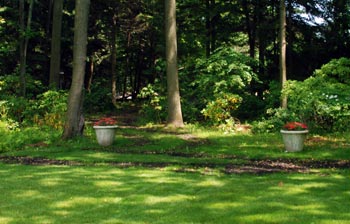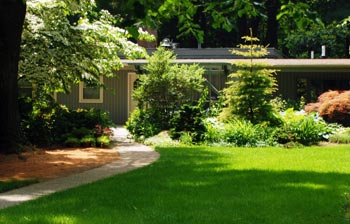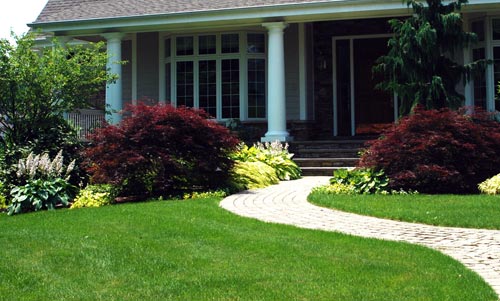
Low Maintenance Lawns in the Midwest
DOWNLOADMay 12, 2016 - Questions about this information? Contact us.
Homeowners sometimes wonder why the lawn across the street looks so good when it appears little maintenance is done. Not all lawns require the same care. Types of grasses and the environmental conditions in which they grow can all have an impact. If you’d like to lower the maintenance needs of your lawn, there are several factors to consider.
A lawn growing in partial shade, or four to six hours of dappled shade, grows slower and has less need for water and fertilizer. However, the grass may not fill in so and it will likely never be the emerald velvet carpet that many people desire. Types of grasses in the lawn will determine the level of care, including light requirements, needed to keep it healthy. Turf-type tall fescue and fine fescue grasses require less fertilizer than lawns dominated by Kentucky bluegrass and perennial ryegrass. Maintenance practices such as mowing height can reduce the need for herbicides.


Lawns growing in partial or dappled shade grow slower and have less need for water and fertilizer. Photo credits: Rebecca Finneran, MSU Extension
Which Midwestern turfgrasses fit into lower maintenance lawn care practices?
A sodded lawn is almost always made up of blends of bluegrass varieties. Kentucky bluegrass lawns are beautiful, but require about 2 to 4 pounds of nitrogen fertilizer annually to maintain a thick, lush appearance. To deliver this much nitrogen, about two to five applications of nitrogen each year will be needed. Lower maintenance lawns in Michigan would have a higher percentage of “fine fescues” or “turf-type tall fescues” and would require one-third to half the nitrogen needed for a bluegrass lawn. Keep this in mind if you are considering over-seeding or putting in a new lawn.

Bluegrass lawns are beautiful, but require 2-4 pounds of nitrogen fertilizer annually to maintain a thick, lush appearance. Photo credit: Rebecca Finneran, MSU Extension
Turf-type tall fescue grasses have a larger root mass than other lawn grasses, improving their ability to handle drought and withstand grub damage. This grass needs less fertilizer and does well with one to three applications of nitrogen. It has good tolerance to wear from foot traffic and does well under summer heat stress. Turf-type tall fescue turf can be thick and healthy with fewer inputs and maintenance, although it will not have the fine, carpet-like appearance of Kentucky bluegrass.
The fine fescues are a group of grasses with varying needs. Creeping red fescue is used frequently in mixes with Kentucky bluegrass providing a good turf, especially for lawns with both sunny and shaded areas. Shade-tolerant fine fescues also require fewer inputs of fertilizer and water, needing two to three applications of fertilizer. It is important to note that no turfgrass does well in dense shade. Also, fine fescues do not grow well under wet soil conditions.
The fine fescue grasses that are best under low maintenance practices in our area of the Midwest are hard and sheep fescue. These are stiff, bluish-green grasses that grow in clumps and are usually mixed with some Kentucky bluegrass that fills in between. They are slow growing and have lower fertilizer needs and do well under droughty conditions. If you have an area that cannot be watered or fertilized regularly, a mix of hard or sheep fescue with bluegrass would be a good choice. Hard and sheep fescue lawns will provide a groundcover needing very little lawn care. It will be a thinner lawn where weeds can persist, but that is not as big of a concern for low maintenance turf.
Maintenance practices to help the vigor of a low maintenance lawn
There are several smart gardening practices that support a low maintenance lawn. Mowing the grass at 3 to 3.5 inches tall reduces the possibility of weed seeds germinating, lessens water loss to evaporation and helps build a larger root mass that is more tolerant to drought. Read the Smart Gardening tip sheet “Mow high for weed and grub control” for more information.
Mowing grass clippings and leaves back into the lawn provides about one-third of the nitrogen needed by the lawn during the season. Grass clippings should not be so heavy as to cover the grass. This could be equal to one application of fertilizer if the lawn was getting three applications a year. Read the Smart Gardening tip sheet “Mulch leaves into turf for a smart lawn” for more information.
Lawns require approximately 1 inch of water per week split into multiple applications. This amount includes natural rainfall. Grasses will go dormant if they do not receive water from rain or irrigation. Dormancy is a normal response to drought; however, if a drought lasts more than three weeks in states like Ohio or four weeks further north in Michigan and similar states, some water is necessary for the grass to survive. A light rainfall or watering of a half an inch will keep the crown alive, even if it appears dormant. Read the Smart Gardening tip sheet “Smart watering for lawns: Don’t let the lawn squeeze you dry” for more information.
For more information on a wide variety of smart gardening articles, or to find out about smart gardening classes and events, visit the Gardening in Michigan website.



 Print
Print Email
Email




